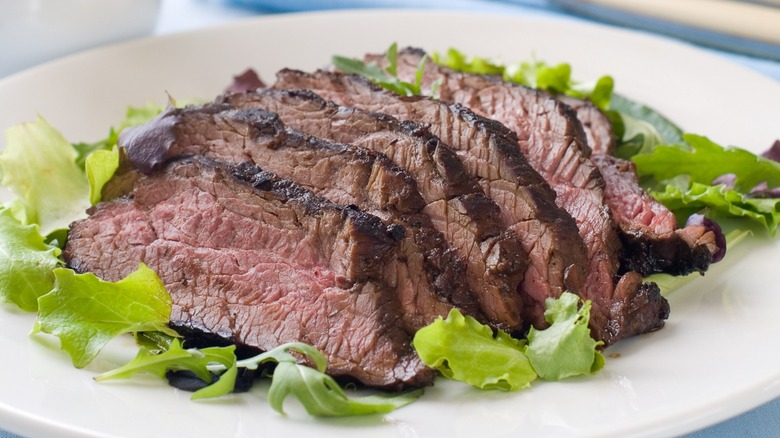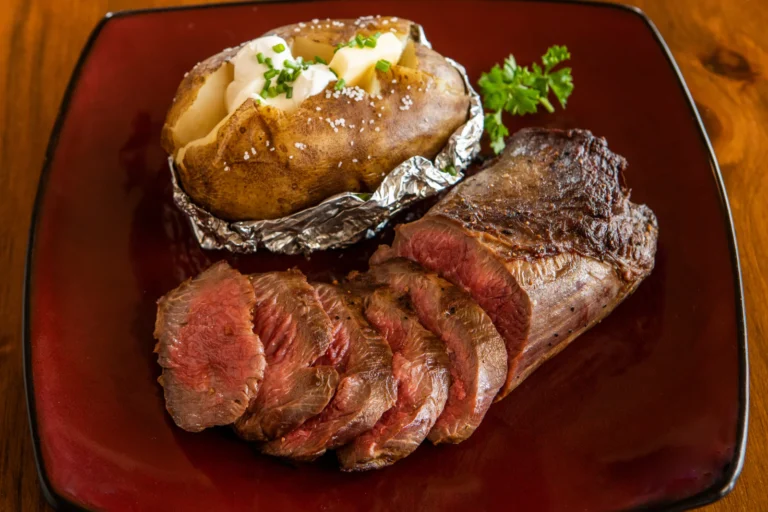Yes, ostrich meat can be eaten rare, similarly to other types of red meats such as beef. Ostrich meat is known for being lean and low in fat, and when cooked properly, it can be enjoyed at varying levels of doneness, including rare or medium-rare.
However, as with any type of meat, it’s crucial to ensure proper food safety. Cooking meat to rare or medium-rare temperatures can pose a higher risk of bacterial contamination compared to well-done meat. Therefore, it’s essential to obtain ostrich meat from a reliable source and handle it safely to prevent foodborne illnesses
What are Unique Qualities of Ostrich Meat Compared to Other Red Meats?
Ostrich meat’s unique qualities, such as its leanness, nutritional benefits, distinct flavor, and versatile cooking characteristics, make it a compelling option for individuals seeking a healthier alternative to traditional red meats like beef or lamb.
Description of ostrich meat’s unique qualities

Lean Protein Content
Ostrich meat is exceptionally lean, containing less fat compared to traditional red meats like beef or lamb.
Its low-fat content makes it a healthier alternative for individuals seeking lean protein sources in their diet.
The meat is often described as having a texture similar to beef but leaner and slightly sweeter.
Nutritional Profile
Ostrich meat is rich in high-quality protein, essential for muscle development and repair. It contains significantly lower levels of fat compared to beef, making it appealing for health-conscious consumers.
Ostrich meat tends to have lower cholesterol levels compared to other meats, making it suitable for those monitoring cholesterol intake.
Flavor and Texture
Ostrich meat is known for its mild, slightly gamey taste that is often likened to a mix between beef and poultry.
When properly prepared, ostrich meat is tender and succulent due to its fine muscle fibers.
Comparison to other red meats (e.g., beef, lamb)
Fat Content and Health Benefits
Ostrich meat has significantly lower fat content compared to beef, making it a favorable choice for individuals watching their fat intake or following specific dietary restrictions.
Due to its lean nature, ostrich meat is often recommended by health professionals as a heart-healthy alternative to fattier meats.
Nutritional Value and Composition
Ostrich meat offers a high protein content similar to beef or lamb, providing essential amino acids necessary for bodily functions.
Its lower cholesterol content distinguishes it as a favorable option for those concerned about cholesterol levels, especially when compared to red meats like beef.
Cooking Characteristics
Ostrich meat’s lean composition requires careful cooking to prevent dryness, but it adapts well to various cooking methods, such as grilling, searing, or roasting.
Despite being lean, when cooked correctly, ostrich meat remains tender and flavorful, with a unique taste that sets it apart from other red meats.
What are optimal ostrich meat cooking methods?
To cook ostrich meat safely and make it tasty, it’s important to know the best cooking ways, use the right temperatures, be careful with food safety, and get good quality ostrich meat.
Optimal cooking methods for ostrich meat
Quick Cooking Methods
Ostrich meat is best cooked using quick methods such as grilling, pan-searing, or broiling due to its lean nature.
Avoid Overcooking
Because of its low-fat content, ostrich meat can become dry if overcooked. Cook it to the desired level of doneness while ensuring it remains tender.
Marination and Tenderization
Marinating the meat or using a tenderizing technique like pounding can enhance its tenderness and flavor.
Resting Time
Allowing the meat to rest after cooking helps retain juices and ensures a moist texture when served.
Temperature guidelines for rare meat consumption
Safe Internal Temperatures
The USDA recommends cooking whole cuts of meat like ostrich to a minimum internal temperature of 145°F (63°C) for medium-rare and 160°F (71°C) for medium. These temperatures ensure food safety without compromising taste.
Using a Meat Thermometer
To guarantee the desired level of doneness and safety, using a meat thermometer to check the internal temperature is highly recommended.
Food safety precautions when consuming rare meats
Quality of Meat
Ensure the ostrich meat comes from a reputable source that follows proper hygiene standards and regulations to minimize the risk of contamination.
Storage and Handling
Practice proper storage and handling techniques to prevent cross-contamination. Keep the meat refrigerated or frozen until ready to cook and follow safe thawing methods.
Sanitary Cooking Practices
Use separate utensils and cutting boards for raw and cooked meats to avoid bacterial contamination. Wash hands thoroughly before and after handling raw meat.
Importance of sourcing high-quality ostrich meat
Trustworthy Sources
Purchasing ostrich meat from reputable suppliers or farms known for high-quality and ethically-raised ostriches ensures better taste and safety.
Health and Safety
High-quality ostrich meat is more likely to be free from additives, antibiotics, or hormones, promoting a healthier choice for consumers.
Flavor and Texture
Well-raised and properly handled ostrich meat tends to have better flavor and texture, enhancing the overall culinary experience.
What is the nutritional value of ostrich meat?

Ostrich meat’s nutritional composition, notably its high protein content, low fat and cholesterol levels, and rich nutrient profile, positions it as a healthier alternative to traditional red meats.
Nutritional composition of ostrich meat
Ostrich meat is a rich source of high-quality protein, containing all the essential amino acids required for various bodily functions, muscle growth, and repair.
Compared to other red meats, ostrich meat is exceptionally lean, containing significantly lower amounts of fat. It’s notably lower in saturated fat, which is linked to cardiovascular issues when consumed in excess.
Ostrich meat is a good source of essential nutrients such as iron, zinc, phosphorus, and B vitamins (particularly vitamin B12), crucial for energy production and maintaining a healthy nervous system.
Health advantages compared to other meats
Ostrich meat’s lean nature translates to lower levels of fat and cholesterol compared to traditional red meats like beef or lamb. This characteristic makes it a healthier option for individuals aiming to reduce their fat and cholesterol intake.
Lower intake of saturated fat and cholesterol is associated with a decreased risk of heart disease, high blood pressure, and other cardiovascular problems.
While being low in fat, ostrich meat still provides a rich array of essential nutrients, making it a nutritious choice for maintaining overall health and well-being.
Considerations for dietary preferences (e.g., low fat content)
Ostrich meat’s low-fat content and high protein content make it a favorable option for individuals focusing on weight management or seeking a lean protein source in their diet.
Its low-fat content and nutritional value also make it suitable for individuals with dietary restrictions or health conditions requiring a controlled fat intake, such as those with heart conditions or specific dietary needs.
Incorporating ostrich meat into a balanced diet can offer a diverse array of nutrients while maintaining a lower fat intake, contributing to overall health and nutrition goals.
FAQ’s
Is ostrich egg unhealthy?
Ostrich eggs are not considered unhealthy; in fact, they are rich in nutrients like protein, vitamins, and minerals, offering a healthy option.
Why can ostrich be served rare?
Ostrich meat can be served rare due to its low-fat content and high-quality protein, making it safe to consume when cooked to the recommended temperature.
How tasty is ostrich meat?
Ostrich meat is often described as having a mild, slightly gamey flavor, similar to beef but leaner, and it’s appreciated for its unique taste.
Why is ostrich meat red?
Ostrich meat appears red due to the presence of myoglobin, a protein that stores oxygen in muscles, similar to other red meats like beef or lamb.
What does a raw ostrich egg taste like?
Raw ostrich eggs have a rich, slightly creamy taste, resembling chicken eggs but with a larger volume and milder flavor.
Is ostrich meat good for humans?
Yes, ostrich meat is good for humans; it’s a lean source of protein, low in fat, and contains essential nutrients, making it a healthy choice when included in a balanced diet.
Final Words
In conclusion, ostrich meat offers a unique choice for those seeking a lean and nutritious alternative to traditional red meats like beef or lamb. Its low-fat content, high-quality protein, and essential nutrients make it a healthy option for various dietary preferences.
Optimal cooking methods, following safety guidelines, and sourcing high-quality ostrich meat are key to enjoying its mild, slightly gamey flavor while ensuring a safe and enjoyable dining experience.
Considering its nutritional value and versatile cooking options, ostrich meat can be a delicious addition to a balanced diet, offering both health benefits and culinary satisfaction.

